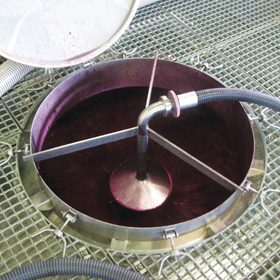VINEYARD AND CELLAR UPDATESeeing that skin contact is a standard practice of red wine making, the orderly management thereof is important to ensure that the colour and tannins of the eventual wine are balanced. Colour is mainly of visual importance, but tannins play a determining role in the taste of wine. A lack of tannins leads to thin, insipid wines, while an excess will cause unbalanced and excessive astringency. Winemakers have different winemaking techniques to manage phenols, tannins and colour during the making of red wine. Phenols are important, because they contribute crucially to the colour, aroma, taste, flavour, body and texture of wine and also play a role in wine stability and maturation potential. The most important red grape and wine phenols are flavonoids, which contribute to colour and astringency. These include amongst others the anthocyanins, which are responsible for the red colour and flavan-3-oles like catechin, epicatechin, epigallocatechin and epicatechingallate. Polymers of flavan-3-oles are also called proanthocyanidins or condensed tannins. Tannins originate from grape skins, seeds and stems and skin tannins are extracted easier than seed tannins. Colour or anthocyanins originate from the skin. |  The mixing of skins and juice is essential to extract colour and tannins. |
Winemakers have different winemaking techniques to manage phenols, tannins and colour during the making of red wine. Phenols are important, because they contribute crucially to the colour, aroma, taste, flavour, body and texture of wine and also play a role in wine stability and maturation potential. The most important red grape and wine phenols are flavonoids, which contribute to colour and astringency. These include amongst others the anthocyanins, which are responsible for the red colour and flavan-3-oles like catechin, epicatechin, epigallocatechin and epicatechingallate. Polymers of flavan-3-oles are also called proanthocyanidins or condensed tannins. Tannins originate from grape skins, seeds and stems and skin tannins are extracted easier than seed tannins. Colour or anthocyanins originate from the skin.
Skin and seed tannins are formed before veraison, but anthocyanin synthesis and tannin ripening occur after veraison. The bitterness of seeds decreases with the ripening of the seed, but the opposite happens with the astringency of it. Viticultural practices like more sunlight exposure, higher nitrogen levels, less soil moisture, moderate canopy, moderate yield, lower soil fertility and smaller berries increase the phenol concentration of grapes and the resulting wine. More light exposure increases the skin tannins, sugar concentration and colour, but decreases the green character, acid concentration and disease potential, although sunburn may occur. It is consequently better if light exposure occurs as early as possible during the ripening cycle. In the cellar the phenolic evolution and consequently the phenol extraction is influenced by variables like time, temperature, concentration gradient, cell permeability, berry ripeness, press programmes and maceration practices.
Cold maceration of the crushed grapes for a few days at 10 to 15°C is used to prevent spontaneous fermentation with potential advantages regarding phenolic extraction. Published data do however vary. The most research found no or a negative influence on colour and some results showed an increase in seed tannins. Cultivar differences also occur with cold maceration with Cabernet Sauvignon and Merlot gaining the most, in comparison with Pinot noir. Draining of juice prior to fermentation increases the skin-juice ratio, which will increase the phenol concentration. In some cases the increase disappears after bottle maturation for six months to a year. Thermovinification increases the skin tannin and anthocyanin concentration, but it can lead to a decrease in cultivar character. It can however be used beneficially for Pinot noir and lower quality grapes. Colour enzymes break down the skin cells and can thus promote tannin and phenol extraction. Enzyme additions are, however, not necessarily beneficial for quality grapes. Higher temperature and alcohol concentration during fermentation cause more extraction of colour and phenols, but lower temperatures will promote more fruitiness and a balance must be found between the two extremes. Phenolic extraction increases during fermentation, whereafter it can decrease again as result of colour adsorption by lees and re-adsorption by the skins at the end of fermentation and extended skin contact. The processing of the cap during fermentation is necessary to keep the skins wet for fermentation, ensuring a more uniform fermentation and optimising the skin and juice contact for extraction. The choice of skin contact process is influenced by the cultivar, experience and the extent of required air contact. The different extraction techniques in order of lower extraction potential are rotating tanks, mechanical punch downs, pump overs, manual punch downs and delestage. Extended skin contact after fermentation tends to increase the seed tannin concentration, but does not increase the colour. An investigation to determine the influence of fermentation temperature and pump overs on tannin extraction, found that skin tannins are extracted early, while seed tannins like catechin are extracted later during fermentation. The extraction of seed tannins is also influenced by temperature, but it is not clear whether the volume of pump overs has an important influence on extraction.
Phenol analyses can be utilised during veraison, ripeness, harvest, fermentation, juice drainage, pressing and blending to ensure that soft, but full-bodied red wines are made. Colour intensity, a tannin index and a ratio between the two analyses can be used (Rieger, 2014).
The required balance between sufficient colour and tannins is consequently the result of different viticultural and enological processes and techniques, which can be managed with the aid of available analytical methods.
Reference
Rieger, Ted, 2014. UC Davis Seminar highlights color and tannin management practices. Wine Business Monthly, September 2014: 48 – 51.













